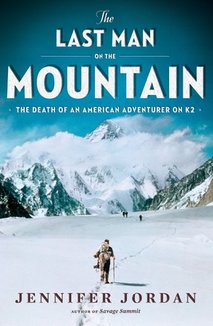
16 Aug 2010 23:51:06
Before “The Last Man on the Mountain: The Death of an American Adventurer on K2" have been written, the Jennifer Jordan was at the base of the mountain in 2002, there she stumbled upon a grisly discovery: "There, laid out on the rocks and ice, was the very recognizable skeleton of a human being: the pelvis, two femurs, and scattered ribs." Jordan prefaces the book with that moment, then backtracks to tell the story from start to finish about how a wealthy American named Dudley Wolfe died alone in a tent 24,700 feet above sea level.
It's a fascinating story , taking the reader from Manhattan high society to the slopes of what the climbing community calls the "Savage Summit" (also the name of Jordan's book about ill-fated female climbers of K2). Readers who aren't familiar with high-altitude mountaineering will have no problem getting into it, thanks to details like the luxury items Wolfe brought with him on the trip: " ... bedroom slippers, a herringbone tweed jacket ... a tuxedo, twenty silk ties and a Brooks Brothers bathrobe." Mountaineering gear, it seems, has come a long way.
Readers who are into high-altitude adventure stories won't be disappointed. These six men (seven counting a British guide they picked up before the 330-mile trek to base camp) tried to do something that wasn't accomplished until 1954. Before Gore-Tex, GPS navigation and oxygen tanks, they sought to put footprints on the second-highest mountain in the world.
But the tragic hero of the tale is always Dudley Wolfe. Jordan wears her journalist hat throughout to try and piece together the circumstances that led to his death. Did expedition leader Fritz Wiessner do everything in his power to get Wolfe down the mountain? Or was he so incapacitated after his failed summit bid that he broke the cardinal rule of climbing?
The dead can't speak, of course, leaving Jordan to stitch together what happened based on interviews, unpublished letters, diaries and deposition transcripts. Taking a page from Sebastian Junger in "The Perfect Storm," she uses italics to indicate dialogue she constructs based on facts gathered in her reporting. It's a device that sometimes slows down the narrative, but the transparency spares the reader of the Bob Woodward experience — you always know who really said what.
By the end of the book there's plenty of blame to go around. Jordan does an admirable job assigning it and letting the reader decide where to place emphasis. She's done her job, refuting the stereotype that Wolfe was a fat and slow climber who tried to be the first to buy his way atop a Himalayan peak. "If we deserve nothing else," writes Jordan, "we deserve to be remembered fairly, for our gifts as well as our faults."
It's a fascinating story , taking the reader from Manhattan high society to the slopes of what the climbing community calls the "Savage Summit" (also the name of Jordan's book about ill-fated female climbers of K2). Readers who aren't familiar with high-altitude mountaineering will have no problem getting into it, thanks to details like the luxury items Wolfe brought with him on the trip: " ... bedroom slippers, a herringbone tweed jacket ... a tuxedo, twenty silk ties and a Brooks Brothers bathrobe." Mountaineering gear, it seems, has come a long way.
Readers who are into high-altitude adventure stories won't be disappointed. These six men (seven counting a British guide they picked up before the 330-mile trek to base camp) tried to do something that wasn't accomplished until 1954. Before Gore-Tex, GPS navigation and oxygen tanks, they sought to put footprints on the second-highest mountain in the world.
But the tragic hero of the tale is always Dudley Wolfe. Jordan wears her journalist hat throughout to try and piece together the circumstances that led to his death. Did expedition leader Fritz Wiessner do everything in his power to get Wolfe down the mountain? Or was he so incapacitated after his failed summit bid that he broke the cardinal rule of climbing?
The dead can't speak, of course, leaving Jordan to stitch together what happened based on interviews, unpublished letters, diaries and deposition transcripts. Taking a page from Sebastian Junger in "The Perfect Storm," she uses italics to indicate dialogue she constructs based on facts gathered in her reporting. It's a device that sometimes slows down the narrative, but the transparency spares the reader of the Bob Woodward experience — you always know who really said what.
By the end of the book there's plenty of blame to go around. Jordan does an admirable job assigning it and letting the reader decide where to place emphasis. She's done her job, refuting the stereotype that Wolfe was a fat and slow climber who tried to be the first to buy his way atop a Himalayan peak. "If we deserve nothing else," writes Jordan, "we deserve to be remembered fairly, for our gifts as well as our faults."

